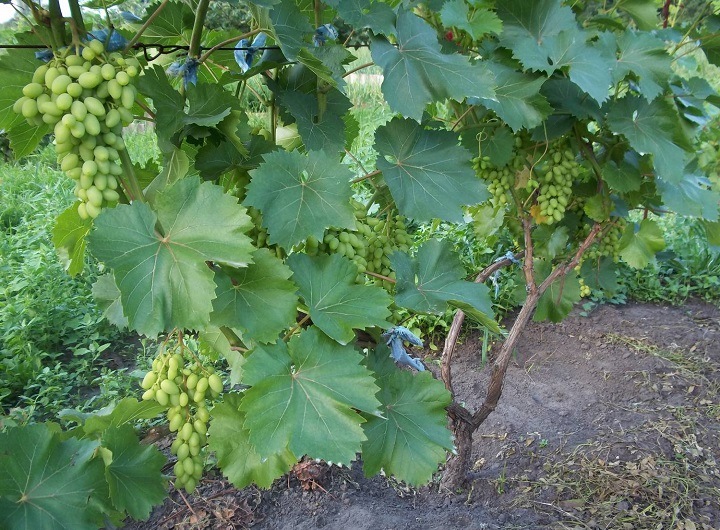
If the grapes are not taken care of annually, then it turns into wild thickets. This leads to a deterioration in the crop: the number of fruits becomes smaller and the quality is worse. To avoid this, it is important to be able to properly care for the plant throughout the summer.
Content
First summer after landing
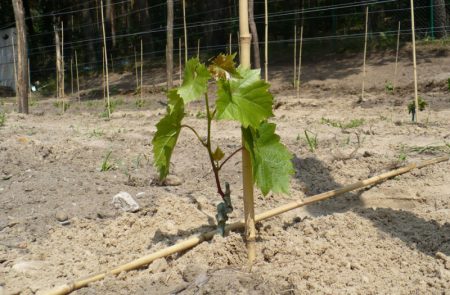
Grapes will give a rich harvest only with proper planting and care. Care of the vineyard in the first year of planting consists of the following procedures:
- loosening and mulching;
- weeding;
- watering.
Mulching and loosening
Mulching and loosening the soil around the bush and in the aisle ensures the preservation of moisture and slows down the germination of weeds. As soon as the first leaves appear on young shoots, it is necessary to form a hole around them for stabbing the trunk.
Tilling is done in a radius of 1.5 meters around the bush. As mulch, straw, humus, hay or sawdust is used.
In June, when the plant has formed 3-4 branches, you need to choose one, the most powerful, and cut the remaining branches. Then the remaining vine by the fall will be strong and well developed.
Weeding
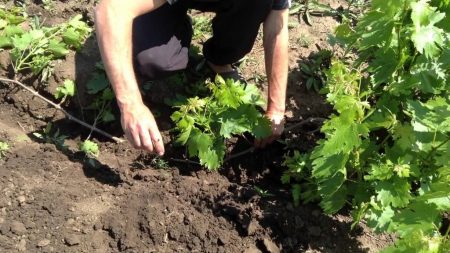
In the first year, it is important to carefully dig out the shallow roots of the plant. This must be done for the good development of roots that are deep in the ground. Indeed, during frosts, the upper roots can freeze, which will lead to grapes not getting enough moisture.
The procedure is as follows: around the bush you need to make a hole of 20 cm, cut off the upper roots with a secateurs, then bury the hole to the first green leaves.
Regular weeding prevents weeds from growing and also allows the soil to breathe. It is especially important to weed the grapes after rains or watering when the ground is covered with a crust.
Watering
Watering shrubs of grapes is necessary once every 7 days. One bush will need 10 liters of water. Watering is necessary until the moment when flowering begins to appear. Various fertilizers can be diluted in water.
When flowering begins or harvest is nearing, irrigation of vine bushes ceases.
Annual Summer Care
Each year, to obtain large and high-quality clusters of grapes, it is important to adhere to certain rules and recommendations. To accelerate the ripening of berries, as well as for the active development of bushes, the following must be done:
- Tying up.
- Topping.
- Stepsoning.
- Chasing.
- The wreckage.
- Removing inflorescences.
- Thinning leaves.
- Top dressing.
Tying
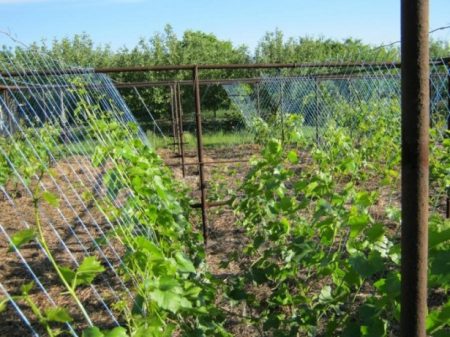
Care for grape bushes begins with tying. Do this in June, when there are no night frosts. The branches are fixed to the trellis and thereby form the correct direction of growth.
Topping
Pinching should be done at the end of June. Pinching consists in shortening the sprouts that bear fruit so that the grape brushes receive more important substances. Pinch the top when the vine grows to 2.5 m. If this is not done, then the clusters get less sugar.
Stepson
The procedure is to destroy unnecessary greenery on the bushes.In the axils of the leaves in the process of growth, stepsons and whiskers are formed that do not affect the quality of fruiting. Therefore, they must be stepson so that all forces are directed to the formation of the crop. The procedure should be done throughout the summer.
Chasing
Chasing is necessary to reduce the growth rate of branches and direct all energy to the formation of grapes. Chasing is the cutting of shoots to the first full leaf. This is after about the 15th sheet. The procedure is done in early August.
Wreckage
The fragment of branches allows you to remove old and weak shoots that do not bring any benefit to the bush, but, on the contrary, take away excess energy. The removal of barren branches is done at the very base of the bush. The procedure is carried out in July.
In order not to harm the plant, it is necessary to break off those branches that are less than 20 cm.
Inflorescence Removal
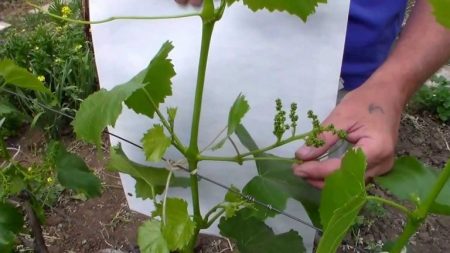
In July and early August, you should begin to remove excess inflorescences. Do this procedure more than once. Due to this, the remaining inflorescences will give large and sweet grapes, which will be less prone to rot and cracking.
Thinning leaves
A month before harvesting, it is important to thin out the leaves. First of all, those that grow in the lower part of the bush, and then creating a shade of clusters, are removed. Thus, the vineyard will be better ventilated, and the berries will receive more sunlight.
Top dressing
Summer top dressing is the addition of superphosphate, nitrogen mixture and potassium to the substrate. This is done before the flowering plants. In late July - early August, when the first berries appear, potassium and phosphorus top dressing should be added to the soil.
In order for the grapes to get enough sugar and the vine to mature better, in August shrubs are sprayed with a solution of potassium monophosphate. You can use infusion of wood ash.
Flowering care
At the beginning of the flowering phase, it is important to trim the ends of the shoots. If this is not done in a timely manner, then the quality of the crop will deteriorate, and the number of fruits in clusters will be many, but they will not be sweet or large. If, nevertheless, the moment was missed, then you will have to pinch the edges of the shoots (more than 20 cm), and this will negatively appear on the growth of the plant.
During flowering, it is important to properly and timely feed the shrubs of grapes. Foliar top dressing from infusion of wood ash can provide the formation of a full-fledged bunch with berries that have a sufficient amount of sucrose. In addition, due to top dressing in the plant, the nucleation of fruiting organs takes place, due to which the vineyard will yield a good harvest next season.
Top dressing is done in conjunction with the treatment of diseases. The procedure is carried out twice in the morning and evening.
Protection against diseases and pests
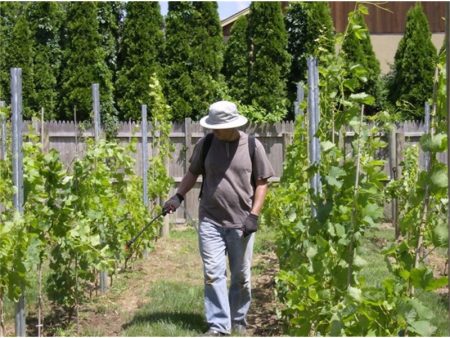
Throughout the summer, it is important to inspect grape bushes every day for serious fungal diseases, as well as pests. A healthy grape leaf has a green color, on which there is no plaque and roughness. If, upon examination of the plant, yellow leaves or ashen plaque were found, then the entire shrub should be urgently treated with special means. It can be oidium or mildea.
Only this is done before the vineyard blooms. Bushes that already bear fruit are best treated with a solution of baking soda or potassium permanganate.
Bunches of grapes also need to be carefully examined. If a rotten, cracked or blackened berry is found, the entire brush must be removed from the bush, as it can be infected.
Conclusion
Caring for a vineyard in the summer in the first year of its life does not require much time and knowledge. It is enough to water it in a timely manner, loosen the earth after each watering or rain, and also weed the aisles from weeds. Subsequent care consists of timely coinage, debris, pinching and pinching.
When removing shoots that do not produce fruit, it is recommended to leave several branches on the bush. On average, if there are three fruit-bearing branches, then one can be left non-fruiting.




 Non-covering winter-hardy grape varieties for Moscow region
Non-covering winter-hardy grape varieties for Moscow region How to keep the vine in winter
How to keep the vine in winter When can I transfer grapes to another place in the fall
When can I transfer grapes to another place in the fall How to cover and prepare grapes for the winter in the suburbs
How to cover and prepare grapes for the winter in the suburbs